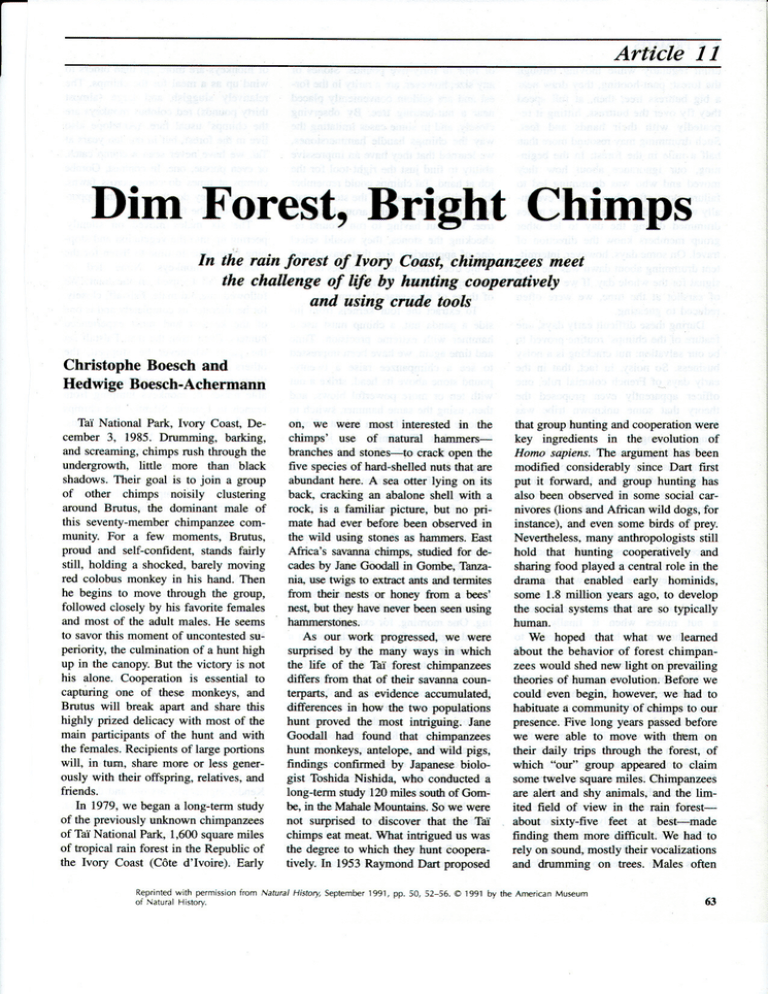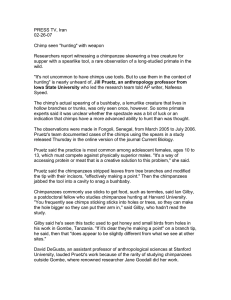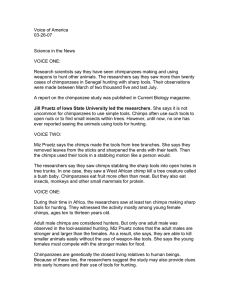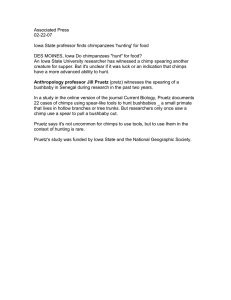Dim Forest, Bright Chimps
advertisement

Article 11 Dim Forest, Bright Chimps In the rain forest of Ivory Coast, chimpanzees meet the challenge of life by hunting cooperatively and using crude tools Christophe Boesch and Hedwige Boesch-Achermann Tal National Park, Ivory Coast, December 3, 1985. Drumming, barking, and screaming, chimps rush through the undergrowth, little more than black shadows. Their goal is to join a group of other chimps noisily clustering around Brutus, the dominant male of this seventy-member chimpanzee community. For a few moments, Brutus, proud and self-confident, stands fairly still, holding a shocked, barely moving red colobus monkey in his hand. Then he begins to move through the group, followed closely by his favorite females and most of the adult males. He seems to savor this moment of uncontested superiority, the culmination of a hunt high up in the canopy. But the victory is not his alone. Cooperation is essential to captUring one of these monkeys, and Brutus will break apart and share this highly prized delicacy with most of the main participants of the hunt and with the females. Recipients of large portions will, in turn, share more or less generously with their offspring, relatives, and friends. In 1979, we began a long-term study of the previously unknown chimpanzees of Tal National Park, 1,600 square miles of tropical rain forest in the Republic of the Ivory Coast (Cote d'Ivoire). Early on, we were most interested in the that group hunting and cooperation were chimps' use of natural hammerskey ingredients in the evolution of branches and stones-to crack open the Homo sapiens. The argument has been five species of hard-shelled nuts that are modified considerably since Dart first abundant here. A sea otter lying on its put it forward, and group hunting has also been observed in some social carback, cracking an abalone shell with a rock, is a familiar picture, but no prinivores (lions and African wild dogs, for mate had ever before been observed in instance), and even some birds of prey. the. wild using stones as hammers. East Nevertheless, many anthropologists still Africa's savanna chimps, studied for dehold that hunting cooperatively and cades by Jane Goodall in Gombe, Tanzasharing food played a central role in the nia, use twigs to extract ants and termites drama that enabled early hominids, from their nests or honey from a bees' some 1.8 million years ago, to develop nest, but they have never been seen using the social systems that are so typically hammerstones. human. As our work progressed, we were We hoped that what we learned surprised by the many ways in which about the behavior of forest chimpanthe life of the Tal forest chimpanzees zees would shed new light on prevailing differs from that of their savanna countheories of human evolution. Before we terparts, and as evidence accumulated, could even begin, however; we had to differences. in how the two populations habituate a community of chimps to our. hunt proved the most intriguing. Jane presence. Five long years passed before we were able to move with th'em on Goodall had found that chimpanzees hunt monkeys, antelope, and:wild pigs, their daily trips through the forest, of findings confirmed by Japanese biolowhich "our" group appeared to claim gist Toshida Nishida, who conducted a sometwelve square miles. Chimpanzees long-term study 120miles south of Gomare alert and shy animals, and the limbe, in the Mahale Mountains.So we were ited field of view in the rain forestnot surprised to discover that the Tal . about sixty-five feet at best-made chimps eat meat. What intrigued us was finding them more difficult. We had to the degree to which they hunt cooperarely on sound, mostly their vocalizations tively. In 1953 Raymond Dart proposed and drumming on trees. Males often Reprinted with permission from Natural History, September1991, pp. 50, 52-56. «J 1991 by the American Museum of Natural History. 63 2 .:. PRIMATES drum regularly while moving through the forest: pant-hooting, they draw near a big buttress tree; then, at full speed they fly over the buttress, hitting it repeatedly with their hands and feet. Such drumming may resound more than half a mile in the forest. In the beginning, our ignorance about how they moved and who was drumming led to failure more often than not, but eventually we learned that the dominant males drummed during the day to let other group members know the direction of travel. On some days, however: intermittent drumming about dawn was the only signal for the whole day. If we were out of earshot at the time, we were often reduced to guessing. During these difficult early days, one feature of the chimps' routine proved to be our salvation: nut cracking is a noisy business. So noisy, in fact, that in the early days of French colonial rule, one officer apparently even proposed the theory that some unknown tribe was forging iron in the impenetrable and dangerous jungle. Guided by the sounds made by the chimps as they cracked open nuts, which they often did for hours at a time, we were gradually able to get within sixty feet of the animals. We still seldom saw the chimps themselves (they fled if we came too close), but even so, the evidence left after a session of nut cracking taught us a great deal about what types of nuts they were eating, what sorts of hammer and anvil tools they were using, and-thanks to the very distinctive noise a nut makes when it finally splits open-how many hits were needed to crack a nut and how many nuts could be opened per minute. After some months, we began catching glimpses of the chimpanzees before they fled, and after a little more time, we were able to draw close enough to watch them at work. The chimps gather nuts from the ground. Some nuts are tougher to crack than others. Nuts of the Panda oleosa tree are the most demanding, harder than any of the foods processed by present-day hunter-gatherers and breaking open only when a force of 3,500 pounds is applied. The stone hammers U!?edby the Tal chimps range from stones of ten ounces to granite blocks 64 of four to forty-five pounds. Stones of any size, however, are a rarity in the forest and are seldom.conveniently placed near a nut-bearing tree. By observing closely, and in some cases imitating the way the chimps handle hammerstones, we learned that they have an impressive ability to find just the right tool for the job at hand. Tal chimps could remember the positions of many of the stones scattered, often out of sight, around a panda tree. Without having to run around rechecking the stones, they would select one of appropriate size that was closest to the tree. These mental abilities in spatial representation compare with some of those of nine-year-old humans. To extract the four kernels from inside a panda nut, a chimp must use a hammer with extreme precision. Time and time again, we have been impressed to see a chimpanzee raise a twentypound stone above its head, strike a nut with ten or more powerful blows, and then, using the same hammer, switch to delicate little taps from a height of only four inches. To finish the job, the chimps often break off a small piece of twig and use it to extract the last tiny fragments of kernel from the shell. Intriguingly, females crack panda nuts more often than males, a gender difference in tool use that seems to be more pronounced in the forest chimps than in their savanna counterparts. After five years of fieldwork, we were finally able to follow the chimpanzees at close range, and gradually, we gained insights into their way of hunting. One morning, for example, we followed a group of six male chimps on a three-hour patrol that had taken them into foreign territory to the north. (Our study group is one of five chimpanzee groups more or less evenly distributed in the Tal forest.) As always during these approximately monthly incursions, which seem to be for the purpose of territorial defense, the chimps were totally silent, clearly on edge and on the lookout for trouble. Once the patrol was over, however,and they were back within their own borders, the chimps Shiftedtheir attention to hunting. They were after monkeys, the most abundant mammals in the forest. Traveling in large, multi-species groups, some of the forest's ten species of monkeys are more apt than others to wind up as a meal for the chimps. The relatively sluggish and 1arge (almost thirty pounds) red colobus monkeys are the chimps' usual fare. (Antelope also live in the forest, but in our ten years at Tal, we have never seen a chimp'catch, or even pursue, one. In contrast, Gombe chimps at times do come across fawns, and when they do, they seize the opportunity-and the fawn.) The six males moved on silently, peering up into the vegetation and stopping from time to time to listen for the sound of monkeys. None fed or groomed; all focused on the hunt. We followed one old male, Falstaff, closely, for he tolerates us completely and is one of the keenest and most experienced hunters. Even from the rear, Falstaff set the pace; whenever he stopped, the others paused to wait for him. After thirty minutes, we heard the unmistakable noises of monkeys jumping from branch to branch. Silently,. the chimps turned in the direction of the sounds, scanning the canopy. Just then, a diana monkey spotted them and gave an alarm call. Dianas are very alert and fast; they are also about half the weight of colobus monkeys. The chimps quickly gave up and continued their search for easier, meatier prey. Shortly after, we heard the characteristic cough of a red colobus monkey. Suddenly Rousseau and Macho, two twenty-year-olds, burst into action, running toward the cough. Falstaff seemed surprised by their precipitousness, but after a moment's hesitation, he also ran. Now the hunting barks of the chimps mixed with the sharp alarm calls of the monkeys. Hurrying behind Falstaff, we saw him climb up a conveniently situated tree. His position, combined with those of Schubert and Ulysse, two mature chimps in their prime, effectively blocked off three of the monkeys' possible escape routes. But in,another tree, nowhere near any escape route and thus useless, waited the last of the hunters, Kendo, eighteen years old and the least experienced of the group. The monkeys, taking advantage of Falstaff's delay and Kendo's error, escaped. The six males moved on and within five minutes picked up the sounds of an- ~ 11. Dim Forest, Bright Chimps other group of red colobus. This time, the chimps approached cautiously, nobody hurrying. They screened the canopy intently to locate the monkeys, which were still unaware of the approaching danger. Macho and Schubert chose two adjacent trees, both full of monkeys, and started climbing very quietly, taking care not to move any branches. Meanwhile, the other four chimps blocked off anticipated escape routes. When Schubert was halfway up, the monkeys finally detected the two chimps. As we watched the: colobus monkeys take off in literal panic, the appropriateness of the chimpanzees' scientific name-Pan came to mind: with a certain stretch of the imagination, the fleeing monkeys could be shepherds and shepherdesses frightened at the sudden appearance of Pan, the wild Greek god of the woods, shepherds, and their flocks. Taking off in the expected direction, the monkeys were trailed by Macho and Schubert. The chimps let go with loud hunting barks. Trying to escape, two colobus monkeys jumped into smaller trees lower in the canopy. With this, Rousseau and Kendo, who had been watching from the ground, sped up into the trees and tried to grab them. Only a third of the weight of the chimps, however, the monkeys managed to make it to the next tree along branches too small for their pursuers. But Falstaff had anticipated this move and was waiting for them. In the following confusion, Falstaff seized a juvenile and killed it with a bite to the neck. As the chimps met in a rush on the ground, Falstaff began to eat, sharing with Schubert and Rousseau. A juvenile colobus does not provide much meat, however, and this time, not all the chimps got a share. Frustrated individuals soon started off on another hunt, and relative calm returned fairly quickly: this sort of hunt, by a small band of chimps acting on their own at the edge of their territory, does not generate the kind of high excitement that prevails when more members of the community are involved. So far we have observed some 200 monkey hunts and have concluded that success requires a minimum of three motivated hunters acting cooperatively. Alone or in pairs, chimps succeed less than 15 percent of the time, but when three or four act as a group, more than half the hunts result in a kill. The chimps.seem well aware of the odds; 92 percent of all the hunts we observed were group affairs. Gombe chimps also hunt red colobus monkeys, but the percentage of group hunts is much lower: only 36 percent. In addition, we learned from Jane Goodall that even when Gombe chimps' do hunt in groups, their strategies are different. When Tal chimps anive under-a group of monkeys, the hunters scatter, often silently, usually out of sight of one another but each aware of the others' positions. As the hunt progresses, they gradually close in, encircling the quarry. Such movements require that each chimp coordinate his movements with those of the other hunters, as well .as with those of the prey, at all times. Coordinated hunts account for 63 percent of all those observed at Tal but only 7 percent of those at Gombe. Jane Goodall says. that in a Gombe group hunt, the chimpanzees typically travel together until they anive at a tree with monkeys. Then, as the chimps begin climbing nearby trees, they scatter as each pursues a different target. Goodall gained the impression that Gombe chimps boost their success by hunting independently but simultaneously,thereby disorganizingtheir prey; our impressionis that the Tal chimps owe their success to being organizedthemselves. Just why the Gombe and Tal chimps have developed such different hunting strategies is difficult to explain, and we plan to spend some time at Gombe in the hope of finding out. In the meantime, the mere existence of differences is interesting enough and may perhaps force changes in our understanding of human evolution. Most currently accepted theories propose that some three million years ago, a dramatic climate change in Africa east of the Rift Valley turned dense forest into open, drier habitat. Adapting to the difficulties of life under these new conditions, our ancestors supposedly evolved into cooperative hunters and began sharing food they caught. Supporters of this idea point out that plant and animal remains indicative . of dry, open environments have been found at all early hominid excavation sites in Tanzania, Kenya, South Africa, and Ethiopia. That the large majority of apes in Africa today live west of the Rift Valley appears to many' anthropologists to lend further support to the idea that a change in environment caused the common ancestor of apes and humans to evolve along a different line from those remaining in the forest. Our observations, however, suggest quite another line of thought. Life in dense, dim forest may require more sophisticated behavior than is commonly assumed: compared with their savanna relatives, Tal chimps show greater complexity in both hunting and tool use. Tal chimps use tools in nineteen different ways and have six different ways of making them, compared with sixteen uses and three methods of manufacture at Gombe. Anthropologist colleagues of mine have told me that the discovery that some chimpanzees are accomplished users of hammerstones forces them to look with a fresh eye at stone tools turned up at excavation sites. The important role played by female Tal chimps in tool use also raises the possibility that in the course of human evolution, - women may have been decisive in the development of many of the sophisticated manipulative skills characteristic of our species. Tal mothers also appear to pass on their skills by actively teaching their offspring. We have observed mothers providing their young with hammers and then stepping in to help when the inexperienced youngsters encounter difficulty. This help may include carefully showing how to position the nut or hold the hammer properly. Such behavior has never been observed at Gombe. Similarly, food sharing, for a long time said to be unique to humans, seems more general in forest than in savanna chimpanzees. Tal chimp mothers share with their young up to 60 percent of the nuts they open, at least until the latter become sufficiently adept, generally at about six years old. They also share other foods acquired with tools, including honey, ants, and bone marrow. Gombe mothers share such foods much less often, even with their infants. Tal 65 2 .:. PRIMATES chimps also share meat more frequently than do their Gombe relatives, sometimes dividing a chunk up and giving portions away, sometimes simply allowing. beggars to grab pieces. Any comparison between chimpanzees and our hominid ancestors can only be suggestive,not definitive.But our studies lead us to believe that the process of hominization may have begun independently of the drying of the environment. Savanna life could even have delayed the process; many anthropologists have been struck by how slowly hominid-associated remains, such as the hand ax, changed after their first appearance in the Olduvai age. Will we have the time to discover more about the hunting strategiesor other, perhaps as yet undiscovered abilities of 66 these forest chimpanzees? Africa's tropical rain forests, and their inhabitants, are threatened with extinction by extensive logging, largely to provide the Western world with tropical timber and such products as coffee, cocoa, and rnbber. Ivory Coast has lost 90 percent of its original forest, and less than 5 percent of the remainder can be considered pristine. The climate has changed dramatically. The harmattan, a cold, dry wind from the Sahara previously unknown in the forest, has now swept through the Tal forest every year since 1986. Rainfall has diminished; all the rivulets in our study region are now dry for several months of the year. In addition, the chimpanzee, biologically very close to humans, is in demand for research on AIDS and hepatitis vac- cines. Captive-bred chimps are available, but they cost about twenty times more than wild-caught animals. Chimps taken from the wild for these purposes are generally young, their mothers having been shot during capture. For every chimp arriving at its sad destination, nine others may well have died in the forest or on the way.>Such prioritiescheap coffee and cocoa and chimpanzees~o not do the economies of Third World countries any good in the long run, and they bring suffering and death to innocent victims in the forest. Our hope is that Brotus, Falstaff, and their families will survive, and that we and others will have the opportunity to learn about them well into the future. But there is no denying that modem times work against them and us.




